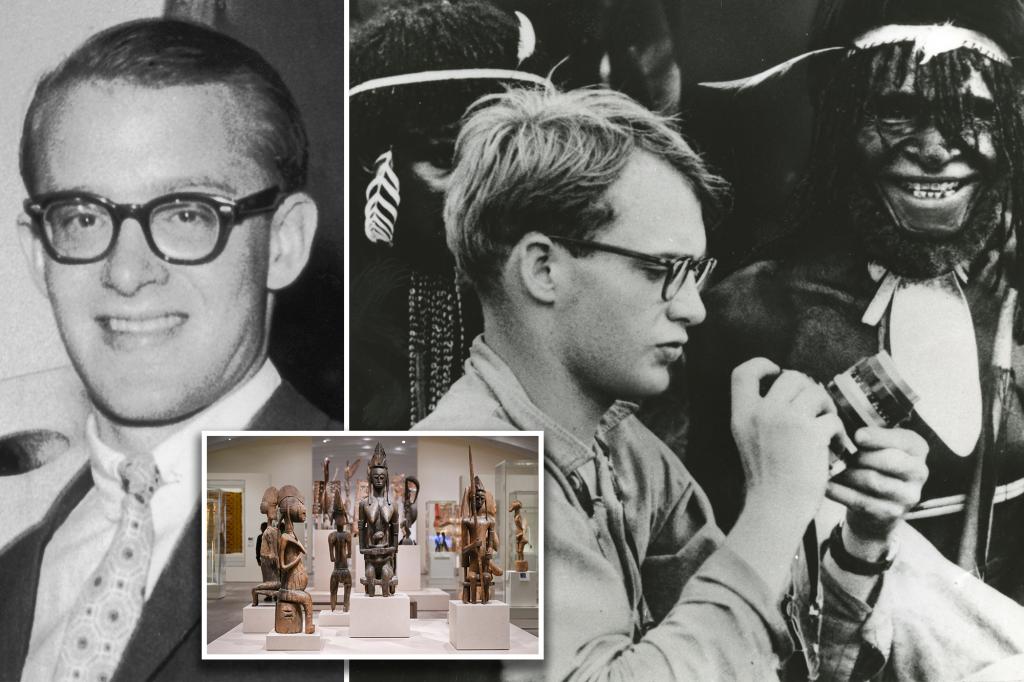Dissatisfied at being remembered merely as oil barons, real estate tycoons, political bellwethers, and lavish philanthropists, at some point the Rockefellers began to specialize in dramatic exits.
Politician Nelson, at least as Johnny Carson would tell it, died doing what he loved best: his aide and alleged mistress Megan Marshack.
But it was Nelson’s son, Michael Rockefeller, whose tragic ending added “eaten by cannibals” to the family lore.
His story has again captured the imagination of New York with the reopening of the Michael C. Rockefeller Wing of the Metropolitan Museum of Art after a refresh that took four years and $70 million.
First opened in 1982, the 40,000-square-foot wing now displays 1,726 artifacts — including the collections of the former Museum of Primitive Art — with the latest scholarship and technology.
“We have the finest surveys of art from these three areas of the world – sub-Saharan Africa, Oceania, and the ancient Americas in a U.S. museum,” Alisa LaGamma, the curator in charge of the wing, told The Post.
The wing also houses more than 400 items Michael collected on his travels — though whether or not it contains pieces created by the very tribe that might have brought about his death is still open for debate.
In March 1961, Michael — a newly minted Harvard history and economics cum laude and the son of the Governor of New York at the time — joined the Harvard-Peabody Expedition to New Guinea. Its mission was to study the Ndani people of the Baliem Valley in the remote western portion of the island. But the 23-year-old Rockefeller had an ulterior motive: The stripling anthropologist was on an adventure to trade fish hooks, axes and pouches of tobacco for great masterpieces of tribal art.
The art would be sent back home to his father’s innovative Museum of Primitive Art — a groundbreaking effort to extol the fetishes, tools and handicrafts of Africa, the Americas, Asia and Oceania in a townhouse mansion at 15 West 54th Street. At a time when these objects of cultures were rotting in museum ethnography cabinets, the new home would place them at eye level with Western fine art.
In September 1961, the young Rockefeller returned to New Guinea accompanied by Dutch anthropologist René Wassing. This time he would venture deep into the jungle swamps of South Papua inhabited by the Asmat people, famed for their well-endowed bisj pole woodcarvings — and for their cannibalistic headhunting.
On November 19, 1961, while sailing the coast of Asmat, their boat overturned. Wassing could not swim, but shore within sight, Rockefeller decided he could make it with an improvised floatation device. He was never seen again.
Of course, the official explanation for Michael’s disappearance was drowning, and, in 1964, a Westchester County judge declared the descendent of John D. Rockfeller legally dead.
“All the evidence, based on the strong offshore currents, the high seasonal tides, and the turbulent outgoing waters, as well as the calculations that Michael was approximately 10 miles from shore when he began to swim, supports the prevailing theory that he drowned before he was able to reach land,” Michael’s twin sister Mary Rockefeller Morgan writes in her 2014 book, “When Grief Calls Forth the Healing: A Memoir of Losing a Twin.”
But the stewpot was the better story.
Almost immediately after Michael’s disappearance, rumors spread that he was alive and had gone native — or that his skull had been found in the clutches of headshrinkers. In 1962, missionaries claimed to have met villagers who confessed to his killing in the village of Otsjanep.
“It was cocktail party lore all through the 60s, 70s and 80s,” publicist R. Couri Hay, whose family had a house near the Rockefeller’s retreat in Maine at the time, told The Post. “I was a kid but I still remember. Nobody could believe it. It became kind of a funny threat. My father would say that if I wasn’t good he would send me away to be eaten by cannibals like Michael Rockefeller.”
In 1977, the documentary filmmaker Lorne Blair wrote in an article in the girlie mag Oui, claiming that he had found the man who had consumed Michael.
A slippery private sleuth named Frank Monte told anyone who would listen that he found Michael’s skull and was paid royally by the Rockefeller family for it. National Lampoon had a heckle. Leonard Nimoy hosted a TV special in 1978 called “In Search of Michael Rockefeller.”
Dozens of books, podcasts, documentaries and magazine articles have tried to prove the cannibal theory. Novels, short stories, rock songs and even an off-Broadway show have mined the incident for subject matter.
Journalist Carl Hoffman makes the best-researched argument that Michael was indeed likely killed and ceremonially eaten by three Asmat tribesmen in his 2014 book “Savage Harvest.”
“In a perverse way,” he writes, “it seemed to level the playing field that this scion of American power could have been not just killed but consumed, cooked and digested and shat out by his opposite — wild men who had nothing, no power, no money, no influence.”
Read the full article here


